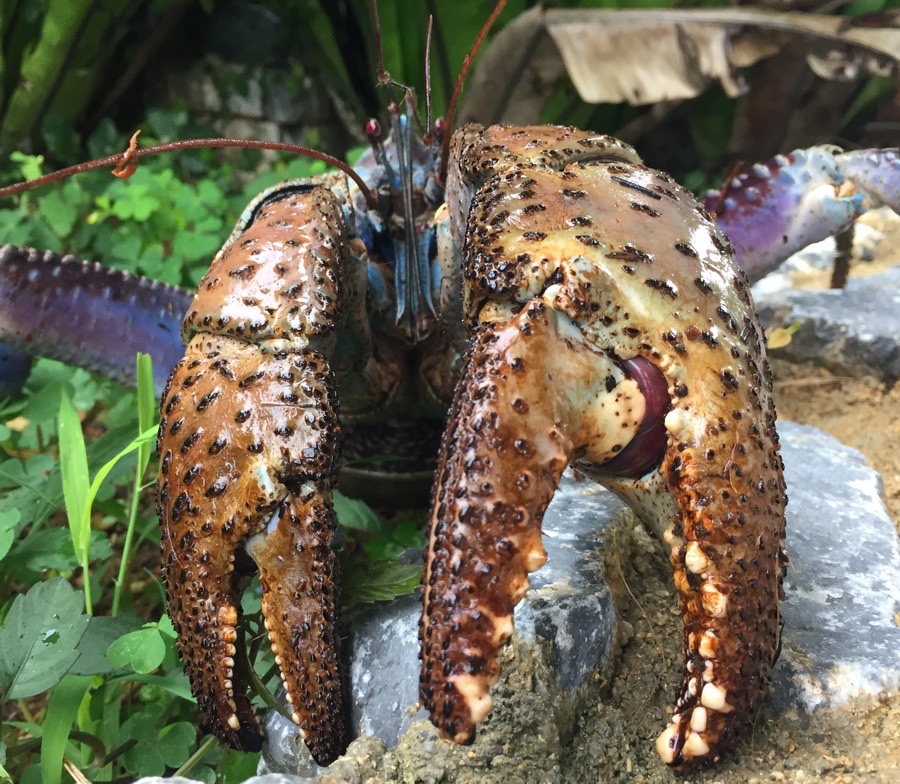Coconut Crab's Pinch Is Strongest in the World

Watch your fingers! New research finds that the hulking coconut crab has the strongest pinch of any animal.
In fact, this crustacean's claws can snap closed harder than most animals can bite — with the exception of alligators, according to the study published Nov. 23 in the journal PLOS ONE.
"During our field study, obtaining data for analysis was challenging, as the large claws of this crab pinched us on multiple occasions," Shin-ichiro Oka, the chief researcher of the zoological laboratory at the Okinawa Churashima Research Center in Japan, and his colleagues wrote in the journal article. [10 Amazing Things You Didn't Know About Animals]
Amazing arthropods
Oka and his team persevered, however, and captured 29 coconut crabs on northern Okinawa to weigh and measure. The coconut crab (Birgus latro) is the largest land-living crustacean. It is a relative of the hermit crab, with whom it shares a common ancestor that lived more than 2 million years ago. Unlike hermit crabs, though, the coconut crab doesn't need a borrowed shell for protection; its body is calcified and hard on the outside.
Coconut crabs are found along islands in the Indian and Pacific oceans. The animals can weigh up to about 9 lbs. (4 kilograms) and are capable of cracking open coconuts with their impressive claws, Oka and his colleagues wrote.
Decapods — a group of crustaceans that includes crabs as well as lobsters and shrimp — can generate the greatest force per body mass with their claws of any group of animals, Oka and his colleagues wrote. But no one had ever tested the strength of the heavyweight coconut crab.
In the field, the researchers used a stainless-steel sensor to test the grips of the 29 captured crabs. Results showed that the maximum grips ranged from 29.4 newtons to 1,765.2 newtons. For comparison, the human bite can generate a force of up to 1,300 newtons at the molars, according to a 2010 study in the journal Proceedings of the Royal Society B.
Get the world’s most fascinating discoveries delivered straight to your inbox.
Feats of strength
Of course, humans are much bigger than coconut crabs. Body size did determine the strength of the coconut crabs' claws, Oka and colleagues found: the larger the crab, the stronger the pinch. Given that the largest coconut crabs weigh around 9 lbs., the researchers calculated that the biggest of the species could generate a pinch with a force of 3,300 newtons, greater than that of any other crustacean.
On a body-mass basis, this force exceeds that produced by all animals other than alligators and their bites, the researchers concluded. Coconut crabs are solitary and aggressive, the scientists wrote, and often battle it out with each other and with potential predators and competitors. Because these animals aren't limited by shell size like their hermit crab cousins, coconut crabs have likely been freed to evolve particularly large bodies and claws, the researchers wrote.
Original article on Live Science.

Stephanie Pappas is a contributing writer for Live Science, covering topics ranging from geoscience to archaeology to the human brain and behavior. She was previously a senior writer for Live Science but is now a freelancer based in Denver, Colorado, and regularly contributes to Scientific American and The Monitor, the monthly magazine of the American Psychological Association. Stephanie received a bachelor's degree in psychology from the University of South Carolina and a graduate certificate in science communication from the University of California, Santa Cruz.
